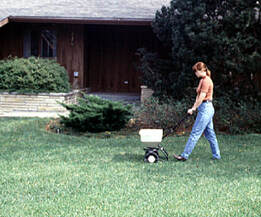 November is the time to give Kentucky bluegrass and tall fescue lawns the last nitrogen application of the season. Why November? Because while top growth slows in response to cool temperatures, grass plants are still making food (carbohydrates) by photosynthesis. A November nitrogen application helps boost the photosynthesis rate. Carbohydrates that are not used in growth are stored in the crown and other storage tissues in the plant. These carbohydrate reserves help the turfgrass green up earlier in the spring and sustain growth into May without the need for early-spring (March or April) nitrogen. Those early-spring nitrogen applications are less desirable because they can lead to excessive shoot growth and reduced root growth. Other benefits of November-applied nitrogen for cool-season grasses include improved winter hardiness, root growth and shoot density. How much should you apply? One to 1 to 1 ½ pounds actual nitrogen per 1,000 sq. ft. of lawn area is sufficient. In order for this application to be effective the nitrogen must be readily available to the plant because the growing season is nearly over. Therefore, for a November application, use a soluble (quickly-available) nitrogen carrier such as urea or ammonium sulfate. Many turfgrass fertilizers sold in garden centers and other retail outlets also contain soluble nitrogen. Avoid products that contain water-insoluble nitrogen (slow-release) for this application. As always, sweep up any fertilizer that gets on driveways, sidewalks, or streets and reapply it to the lawn. (Ward Upham) 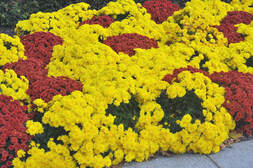 As soon as garden chrysanthemums are done flowering, you may cut the plants back to 2 to 3 inches high. Some gardeners prefer to leave the top growth so that it provides some protection from fluctuating soil temperatures. If you choose to cut the tops off, apply a layer of mulch over the top of your mums after the ground has frozen or if the forecast calls for a sharp drop in temperature. Mums should not completely dry out during the winter. It may be necessary to water occasionally if sufficient rain or snow has not fallen. (Ward Upham) 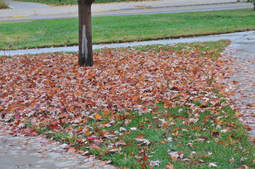 It's that time of year again. Leaves are rapidly falling from deciduous trees so it's a good time to stop and think about options for handling the litter. Although a scattering of leaves won’t harm the lawn, excessive cover prevents sunlight from reaching turfgrass plants. Turf left in this state for an extended period will be unable to make the carbohydrates needed to carry it through the winter. There are options for dealing with the fallen leaves other than bagging them up and putting them out for the trash collector. Composting is a great way to handle the refuse. Compost can then be used in the vegetable garden and flowerbeds. An even easier method of making good use of the leaves is direct incorporation in either vegetable gardens or annual flower beds. Use a lawn mower with a bagging attachment to chop and collect the leaves. Transport them to the garden or bed and apply a 2 to 3 inch layer of leaves on the surface of the soil and then till them in. Repeat the process every couple of weeks until you run out of leaves or the weather becomes too cold or the soil becomes too wet. With luck, you should be able to make 3 to 4 applications this fall. Another option is to mow the leaves with a mulching mower and let shredded leaves filter into the turf canopy. (A side-discharge mower also will work, but it won't shred the leaves as thoroughly.) This method will be most effective if you do it often enough that leaf litter doesn’t become too thick. Mow while you can still see grass peeking through the leaves. You may wonder whether this practice will be detrimental to the lawn in the long run. Research at Michigan State University in which they used a mulching mower to shred up to about one pound of leaves per square yard of lawn (one pound is equal to approximately 6 inches of leaves piled on the grass) for five consecutive years, found no long-term effects of the shredded leaves on turf quality, thatch thickness, organic content of the thatch, or soil test results (pH, nutrients, etc.). If you mow leaves and have a cool-season lawn, it makes sense to be on a fall nitrogen fertilization program and core-aerate in the fall (things you should be doing anyway). If you have a warm-season lawn, you can still use this technique but wait to fertilize and core-aerate until next late May or early June. (Ward Upham) 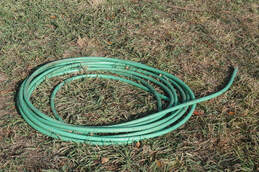 Hoses and shallow irrigation lines may be damaged over the winter if water is not drained. If there is a main shut-off valve for the system, close it and then run through the zones to make sure any pressure has a chance to bleed off. Lawn irrigation systems usually have shallow lines. Though some lines may be self-draining, check to be sure there are no manual drains. If manual drains are present, they should be opened. Be sure to map them so they can be closed next spring before the system is pressurized. If there are no manual drains the system should be blown out with an air compressor. Lawn irrigation companies often offer this service. Drain hoses by stretching them out and coiling them for storage. Water will drain as you pull the hose toward you for coiling. Store in a protected place. UV light can make hoses brittle over time. (Ward Upham) 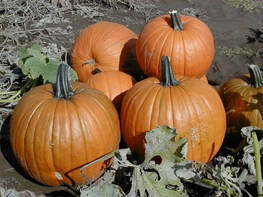 Now that Halloween will soon be past, you may be wondering what to do with the pumpkins that were used to decorate for the holiday. Consider roasting the seeds before freezing temperatures destroys the pumpkin fruit. Cut open the pumpkin and remove the seeds and stringy material. Seeds should be washed and dried and the “strings” discarded. Toss the seeds with a little oil before roasting. Flavor can be enhanced by adding a sprinkling of salt to the oiled seeds. Seeds can then be spread on a cookie sheet and roasted for about 25 minutes at 325 degrees F. Times may vary depending on the size and moisture content of the seed. Seeds are done when they turn a golden brown. If seeds are not eaten immediately, store in a zip closure bag in the refrigerator. (Ward Upham) 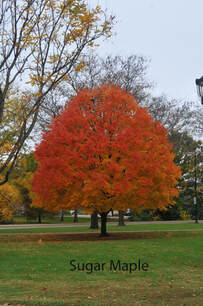 Part of the allure of fall foliage is color variation. There are trees that turn red, purple, yellow, orange and brown. Specific plant pigments determine individual colors. Foliage derives its normal green color from chlorophyll, the substance that captures the energy of the sun. Other pigments produce fall colors. Reds and purples are caused by anthocyanins, yellows by xanthophylls, and oranges by a combination of carotenes and xanthophylls. Browns are the result of tannins present in the leaf. Most of these substances are present throughout the growing season but are masked by the green color produced by chlorophyll. Anthocyanins are the exception and are produced after the chlorophyll is destroyed in the fall. If you have ever seen pictures of New England in the fall, you have probably wondered why trees in Kansas usually do not color as well. This difference is partly because of the tree species prevalent in New England. Certain oaks and maples naturally produce good color. Coloring also is influenced by the weather. Warm, sunny days and cool nights are ideal for good color. The sunny days encourage photosynthesis and, thus, sugar accumulation in the leaves. As fall progresses, each leaf develops an abscission layer at the base of the petiole, or leaf stem, that prevents these sugars from being transported down the trunk to the roots for storage. This high sugar content in the leaves produces more intense colors. Cloudy days and warm nights prevent some of the sugar accumulation in the leaves and results in less vibrant colors. Weather during other parts of the growing season also can have an effect. Heavy rains in the early spring or hot, dry weather during the summer can both have a deleterious effect on fall color. The length of time a tree maintains fall color also depends on weather. Reds, yellows and oranges are short-lived when trees undergo frosts and freezes. (Ward Upham) 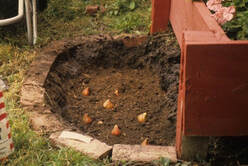 Generally, it is recommended to plant hardy bulbs (especially daffodils) in October to give them enough time to root before winter. But it is certainly not too late to plant them in early November. As long as the soil temperatures are above 40 degrees F, the bulbs should continue root development. You can find the previous week’s soil temperature readings for areas across the state from our Weather Data Library. Although many of the best bulbs have probably already been purchased, garden centers may still have a good selection. Be sure to select large, firm bulbs that have not begun to sprout. While many bulbs can adapt to a wide range of soil types, none can tolerate poorly drained soil. Prepare the planting bed by adding organic matter such as peat moss, well-rotted manure, or compost and mix into the soil. Adequate fertility is essential. It is best to rely on a soil test to determine what nutrients are needed. Garden soils that have been fertilized regularly in the past may have excess levels of phosphorus. Excess phosphorus can interfere with the uptake of other essential micronutrients though levels need to be extremely high to be of concern. In cases where levels of phosphorus are high, it would be better to use a fertilizer relatively high in nitrogen such as a 29-5-4, 27-3-3, or something similar. Although these are lawn fertilizers, they will work well for our purposes as long as they don’t contain and weed preventer or weed killer. Apply these fertilizers at the rate of 2/3 pound (3 cups) per 100 square feet. Organic sources of fertilizers low in phosphorus include blood meal (12-0-0) applied at 5 to 10 pounds per 100 square feet, cottonseed meal (6-0.4-1.5) applied at the rate of 10 pounds per 100 square feet and soybean meal (7-2-1) applied at the rate of 8 pounds per 100 square feet. In the absence of a soil test, or if phosphorus is needed, add a low analysis, balanced fertilizer such as 5-10-5 or 6-10-4 at the rate of 2 to 3 pounds (4 to 6 cups) per 100 square feet of bed. Mix all amendments thoroughly with the soil before planting the bulbs. The size and species of the bulb determines how deep to plant. In general, the depth to the bottom of the bulb should be about 2 to 3 times the size of the bulb, but check the planting instructions specific to each particular flower. (Ward Upham) 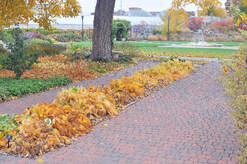 Fall is traditionally a time for cleaning up gardens. Normally, we recommend clear-cutting dead stems to help control insect and disease problems. With herbaceous perennials that have been pest free, you might want to consider leaving some to provide structure, form, and color to the winter garden. For example, ornamental grasses can be attractive even during the winter months. But those near structures should be cut to the ground because they can be a fire hazard. Perennials with evergreen or semi-evergreen foliage can provide color. Of course, some perennials are naturally messy after dormancy and should be cut back in the fall. Foliage can be left for other reasons. For example, foliage left on marginally hardy plants such as tender ferns helps ensure overwintering of plant crowns. Also, seed heads on some perennial plants can provide seed for birds. (Ward Upham) |
AuthorsCynthia Domenghini runs the Horticulture Response Center in the Department of Horticulture and Natural Resources at Kansas State University. Other contributors include K-State Extension Specialists. Archives
March 2024
Categories
All
|
| K-State Research and Extension Horticulture Newsletter |
|
 RSS Feed
RSS Feed
